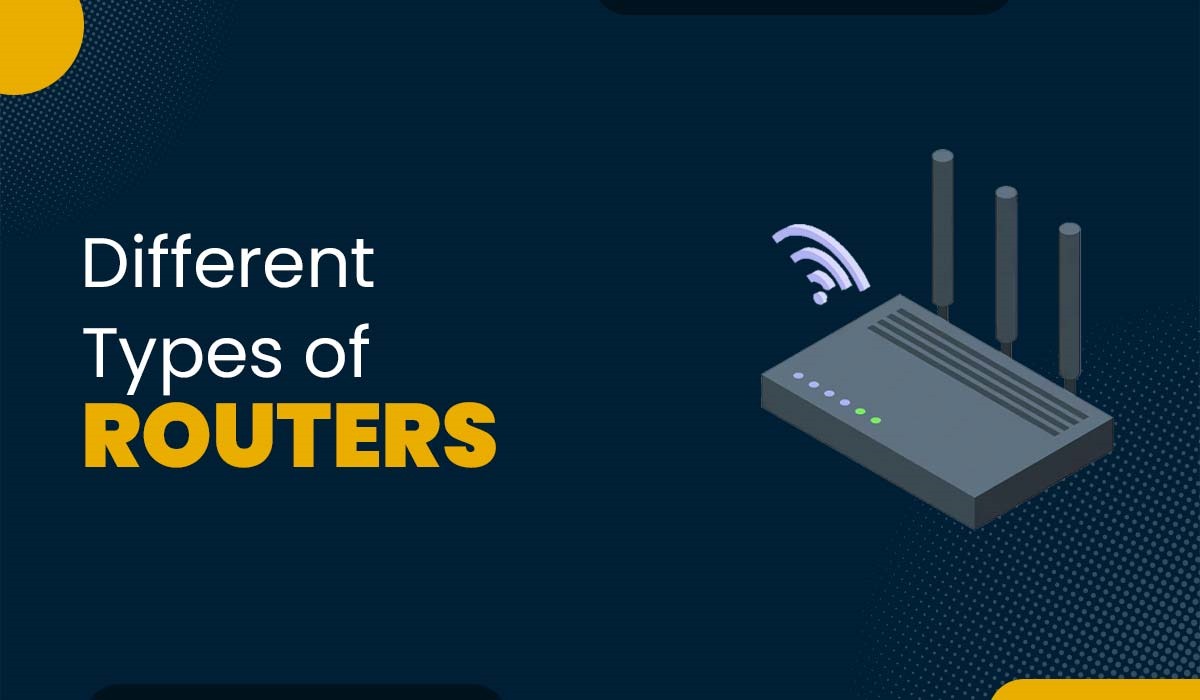Introduction
Modern routers play a crucial role in the current digital world, where communication is everything. From watching your favorite television series on an online platform to telecommuting, routers make sure that your connection is uninterrupted as you move from one device to the next. However, are you aware that there are various types of routers available to suit a particular function?
Therefore, it is crucial to select the correct router that allows you to surf the internet at an appropriate speed and efficiency. Regardless of whether you need a router for home use, a small business or a commercial building, knowing what types of routers are out there will be useful. In this blog, we will discuss the different categories of routers, such as wireless routers, wired routers, core routers and edge routers. We will also provide the various uses of these routers and how they are used.
Summary: Routers are essential for managing internet traffic, connecting devices, and ensuring network security. Various types of routers, like wireless, core, edge, SOHO, Virtual, Gateway, Bridge and broadband routers, serve different needs for homes, businesses, and large enterprises.
Before moving any further and discussing the different types of routers, let us first understand the functions of routers.
What are the Functions of Routers?
A router is a device used to join networks and manage traffic between the networks. The major role of a router is to monitor internet traffic and route them to the appropriate locations. Whenever you are sending an email, watching a video, or visiting a website, the router makes sure that the information gets through. To ensure optimal performance, routers need to be properly configured by setting up IP addresses, defining routing protocols, and enabling security features such as firewalls and encryption.
Routers also provide IP addresses to other devices involved in your network, thus allowing them to relay messages. They work as a barrier to access your network by anyone who is unauthorized to do so. Further, routers can allocate the bandwidth to important tasks such as video calls, etc. Routers allow users to interconnect multiple devices and share the internet, files, and other device resources such as printers.
Let us now look at the different types of routers available and their use cases.
Types of Routers
Below, we have discussed different types of routers that are being used for various purposes in almost every industry.
1. Wireless Router
Wireless routers are devices that are mainly used to connect a computer to the internet modem and make the network available without wires. This is where several devices, for example, smart phones, laptops, tablets. Smart TVs, etc., can access the Internet without wires.
Wireless routers operate through the use of radio signals. They are simple to install and suitable for residential, commercial or any area where individuals employ a range of wireless devices.
Wireless routers that are being produced today can handle high speeds, and you also get options such as dual-band or tri-band routers that help in getting less interference. It makes communication easy and offers better solutions for all your internet-related issues.
2. Core Router
A core router is defined as extremely valuable equipment that is applied in big networks, like Internet providers or large companies. Its primary function is to guide the flow of data frames inside or across a network at a very fast pace. Unlike traditional routers, core routers are purposely built to deal with large traffic and are implemented with high speed.
It links different parts of a network and helps communication between those two parts. Hubs or core routers usually do not transmit Wi-Fi signals; they are just responsible for controlling the traffic between network centers. These routers support thousands of connections and, therefore, are best suited for large networking environments such as data centers and telecom service providers.
3. Edge Router
Next in the list of types of routers is Edge Router. An edge router is a device that provides communication between internal networks, including business or home networks, and external networks or the internet. It is situated at the periphery of a network and performs data entry into and out of a network.
Edge routers are also used to determine by which path the data is to be transferred from your private network to other public networks. Edge routers have Firewalls and VPN capabilities as well as provide you with the protection from external threats to your network.
Examples of edge routers are CISCO ISR, MikroTik EdgeRouter, Juniper MX Series and Ubiquiti EdgeRouter. These devices are most used by businesses and ISPs to proficiently manage flow at the network edge.
4. SOHO (Small Office/Home Office) Router
A SOHO router is specifically intended for use in small offices or home offices. It is equipped with the internet as well as intended and designed networking solutions for small settings better known as office environments. These routers are not very complicated and are all in one device that can act as standard routers, provide wireless connectivity and even basic security features in one device.
SOHO routers are perfectly suitable for linking a couple of devices, starting from computers, printers and smartphones to the internet. They also have capabilities to provide Wi-Fi, port forwarding and firewall protection to make a connection safe and stable.
Some of the examples of the SOHO routers are TP-Link Archer Series, Netgear Nighthawk Series, ASUS RT Series and Linksys EA Series. Although these devices are cheap, they are suitable for those people who require fundamental solutions to networking, focusing on small-scale operations.
5. Virtual Router
A virtual router is a router that executes the physical features of a router but is defined in a virtual platform. It can be used in cloud computing, virtualized computing networks, or any other network that requires flexibility and scalability.
One can assign duties such as managing the flow of traffic in the network, controlling the IP addresses, and even management of secure connections. Most importantly, it does not require the physical routers. It is easy to install, thus convenient for businesses which are planning to cut costs and conserve space.
Some of the virtual routers include Cisco Cloud Services Router (CSR 1000V), MikroTik CHR (Cloud Hosted Router), and VyOS. They are implemented extensively in virtual network environments, data centers, cloud to provide network connectivity for a dynamic network.
6. Broadband Router
Next type among types of routers is Broadband Router. A broadband router is, in fact, a hub that links the home or office network to a broadband connection, for example, DSL, fiber optic line, or cable. It allows several devices, such as computers, mobile phones, and smart TVs, to connect to the same network.
Most broadband routers come with wired and wireless connections so that you can easily connect devices with or without cables. They also contain other elements such as firewalls, parental control, and Wi-Fi security to shield your connection.
Some of the broadband routers are TP-Link Archer AX Series, Netgear Nighthawk Series and ASUS RT-AX Series. Such routers are best suited for home and office browsing, watching movies, playing online games, and even working remotely in the comfort of your home.
7. Core/Gateway Router
A core/gateway router is a very powerful device which is central to regulating data traffic within the network domain as well as network domains beyond the network. It helps manage communication within a network by connecting different parts, like a core router, and also provides access to outside networks, like the internet, functioning as a gateway router.
These routers are widely employed in big corporations, ISPs, and data center organizations for the interpretation of internal networks and external entities. They use high-speed connections and innovative routing conventions in an effort to handle huge data traffic.
Core/gateway routers include Cisco, ASR Series, Juniper, MX Series, Huawei, NE Series routers, etc. These networking devices are mandatory for providing control, stability, security and reliability in large or diverse networks.
8. Brouter (Bridge Router)
A brouter or a bridge router is a device that employs attributes from both a router and a bridge. It can act as a router, to transmit data packets from one network to the other and as a switch to control devices within a given network.
The brouters, therefore, are particularly ideal in networks that have to perform both the routing and bridging functions. They define where to pass data packets in another network (routing) or in the same network (bridging), depending on the target.
These devices are regularly utilized in networks that require a blend of the two categories. Some of the devices include certain models that both Cisco and Juniper have embedded with bridging and routing capabilities.
We have discussed different router types along with their uses and examples. Let’s understand the importance of routers in our day-to-day activities in business settings.
Importance of various Types of Routers
Different router types play a critical role in both home and business networks. They connect different devices and ensure seamless communication between them by directing data to the right destinations. Here’s why routers are so important:
- Efficient Data Routing: Routers manage the flow of data across networks, ensuring it reaches the correct device. This is essential for everything from web browsing to streaming and video conferencing.
- Network Security: Routers provide security by acting as a barrier between the internal network and the outside world. They help protect against cyber threats by filtering incoming and outgoing traffic.
- Multiple Device Connectivity: With a router, multiple devices can connect to the internet or a local network without the need for separate connections. This is crucial for both personal and professional use.
- Resource Sharing: Routers allow devices to share resources, like printers, files, and internet access, making it easier to collaborate and manage systems.
Frequently Asked Questions
Q1. What is a category 6 routers?
A “Category 6 router” refers to a router that supports the LTE Category 6 standard, which means it can achieve maximum download speeds of up to 300 Mbps and upload speeds of up to 50 Mbps.
Q2. How dual band router is different from single band routers?
A dual-band router supports both 2.4 GHz and 5 GHz frequency bands, offering better performance and less interference compared to a single-band router.
Q3. What is a mesh router?
A mesh router system consists of multiple routers working together to provide seamless Wi-Fi coverage across larger areas by creating a mesh network.
Q4. What is a router?
A router is a device that forwards data packets between computer networks. It connects different networks, typically a local area network (LAN), to the internet.
Conclusion
In conclusion, choosing the right router types is essential for a secure and reliable Internet connection. This blog helps you understand the different types of routers to make the best choice for your home or business needs. Each router type serves specific purposes, whether for everyday browsing or managing heavy data traffic in larger companies. With this guidance, you can easily find the router that offers the best online experience for you.





